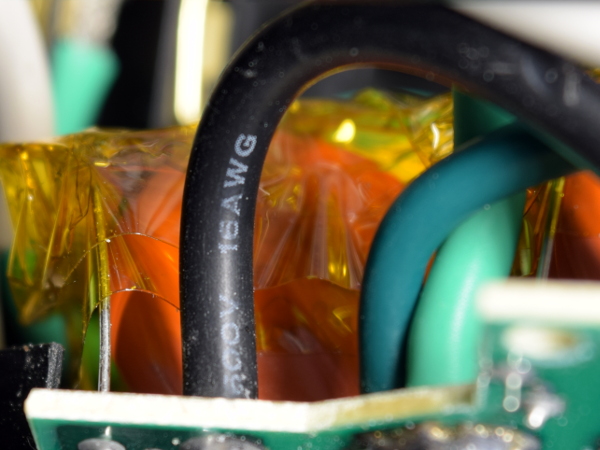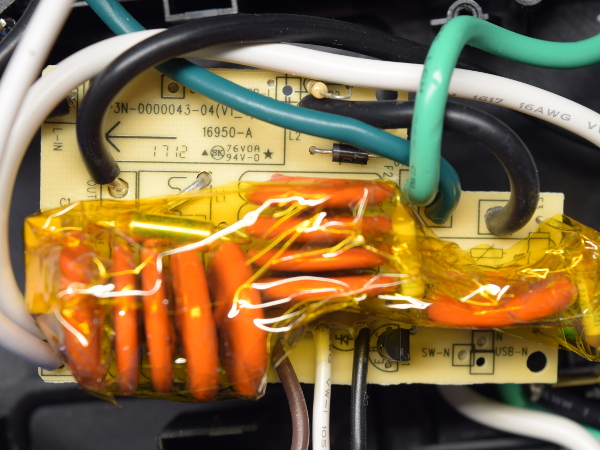AmazonBasics ABHT1208TC Surge Protector Tear-Down
Breaker Switch
When I saw the clear plastic rocker, I was expecting an indicator switch. That's not the case, though. The third terminal for the indicator’s neutral connection is missing. Since the top does have LED indicators for ground fault and protection, I concede that such a switch would have been redundant.
Based on the documentation I could find for this protection switch, its trip time can exceed one second at 300% overload. Since distribution panel breakers are at least an order of magnitude faster, that explains why I’ve never seen a surge protector breaker switch trip.
MORE: APC BN650M1-CA UPS Tear-Down
MORE: CyberPower EC350G Tear-Down
MORE: APC BGE90M-CA Tear-Down
Internal Wire Gauge
Although the power cord is #14, all of the internal wiring is #16. To be fair, losses in 10cm of #16 are still negligible next to 2.4m of #14, and wiring inside the power bar isn’t as tightly packed as the cord's.
MORE: APC BN650M1-CA UPS Tear-Down
Get Tom's Hardware's best news and in-depth reviews, straight to your inbox.
MORE: CyberPower EC350G Tear-Down
MORE: APC BGE90M-CA Tear-Down
Broken Strands
Look at that beautifully tinned wire. Unfortunately, four of its strands broke during stripping or preparation. While reviewing photographs, I noticed that double-insulated wires are being used for the hot-side wiring (the central insulation is white with a thin black outer layer). Double-insulated wiring with high contrast layers is used to facilitate visual identification of compromised insulation.
MORE: APC BN650M1-CA UPS Tear-Down
MORE: CyberPower EC350G Tear-Down
MORE: APC BGE90M-CA Tear-Down
Slight Nick
At some point during the unit’s assembly, a small chunk of the black wire’s insulation was shaved off, though not enough to reveal the white insulation underneath. We're still good to go.
MORE: APC BN650M1-CA UPS Tear-Down
MORE: CyberPower EC350G Tear-Down
MORE: APC BGE90M-CA Tear-Down
Indicator Board
There isn’t much to see on this tiny board. Since all power has to pass through the main thermal cut-off fuse on the surge protection board, the "protected" LED's only job is to show that the surge protector is still receiving power. In other words, the main cut-off hasn’t blown.
MORE: APC BN650M1-CA UPS Tear-Down
MORE: CyberPower EC350G Tear-Down
MORE: APC BGE90M-CA Tear-Down
Surge Suppression Board Back
The soldering quality looks pretty good, with minimal flux residue around the manual wire soldering jobs and no apparent cold or under-filled solder joints.
MORE: APC BN650M1-CA UPS Tear-Down
MORE: CyberPower EC350G Tear-Down
MORE: APC BGE90M-CA Tear-Down
Surge Suppression Board Top
Where does AmazonBasic’s surge suppression come from? A total of 10 MOVs, the four thicker ones being 20D471s and the rest likely either 20D271Ks or 20D201Ks. I’m guessing here, as none of them face outward for me to read numbers from, and I did not want to rip the tape off. For what it's worth, there is also a tiny 10nF Y-class capacitor on the left.
MORE: APC BN650M1-CA UPS Tear-Down
MORE: CyberPower EC350G Tear-Down
MORE: APC BGE90M-CA Tear-Down
Skimping On Filtering
The board layout had provisions for a filter choke meant to separate the first bank of three MOVs (directly across hot and neutral after the thermal shut-off fuse) from the second bank of two MOVs downstream from said inductor.
I was tempted to dig through my scavenged parts bin to find a suitable choke to put in there, but did not find any with suitably thick wire gauge.
MORE: APC BN650M1-CA UPS Tear-Down
MORE: CyberPower EC350G Tear-Down
MORE: APC BGE90M-CA Tear-Down
Why Inductors Matter
Inductors oppose any sudden change in the current passing through them, which makes them ideal for rejecting short-lived voltage transients. How much of a difference can a modestly-sized inductor make to the strain put on other transient suppression devices? Here’s a simple test circuit with two quasi-ideal 200V TVSS', one directly across simulated live-neutral and the other with an extra 22µH inductor in series, both branches subjected to the same 6kV pulse source.
MORE: APC BN650M1-CA UPS Tear-Down
MORE: CyberPower EC350G Tear-Down
MORE: APC BGE90M-CA Tear-Down
Simulation Results, Current
Inserting a mere 22µH in series reduces peak current through the diode from 2778A to 890A, a 68% reduction in transient suppression strain. Since MOV lifespan is heavily dependent on peak energy dissipation, using inductors upstream to reduce current rise rate and peaks considerably improves the life expectancy of downstream MOVs.
MORE: APC BN650M1-CA UPS Tear-Down
MORE: CyberPower EC350G Tear-Down
MORE: APC BGE90M-CA Tear-Down
-
Zaporro "I’m guessing here, as none of them face outward for me to read numbers from, and I did not want to rip the tape off."Reply
Is this a joke? Most imporant part skipped because .... yea why? Its taken apart, there is no warranty anymore, it takes 1 second to rip tape with a knife and be thorough in a review.
Also, this and 99% of so called "surge protectors" look about the same and work the same, they are at most overglorified power splitters with on-off switch and indicator. Sure they might "protect" hardware from tiny spikes caused by say toilet ventilation fan but thats it. Any serious surge of installation fault will go through it like hot knife in butter. As far as RF/noise protection goes, most of mid/high range PSUs have it built in.
If someone really cares for their hardware and want real protection (instead of something to just to take it off your mind with illusion of safety) you go at minimum for AVR type UPS or perfectly full On-Line UPS type. -
Daniel Sauvageau Reply
Depending on where you live, "warranty void if opened" may have no legal standing. Where I live, if you can demonstrate with reasonable certainty that whatever you did has nothing to do with the original reason something needed to be open for repair, the manufacturer still has to fix the original fault even if you killed something else in the process of attempting to fix the original problem.20621770 said:Is this a joke? Most imporant part skipped because .... yea why? Its taken apart, there is no warranty anymore, it takes 1 second to rip tape with a knife and be thorough in a review.
As for why I didn't bother ripping the tape, that's simply because 20D201 or 20D271 doesn't really make that much of a difference: in case of a major surge, the full protection won't be reached until the 20D471s kick in and 270V is still within the normal input range of universal switching supplies which have to handle ~400V peak input. Also, that tape is there to keep the MOVs' heat trapped with their respective thermal fuses in case one of the MOVs overheats. Since I bought this power bar to give to my mother, I didn't want to mess with the original tape which is part of the device's safety mechanisms. If you dig out my past tear-downs, you will see that I've never bothered to remove shrink/tape from MOVs if I couldn't easily put it back on either - unless I had no plan to use the device post tear-down.
If you think a UPS will protect anything from surges, you are sorely mistaken: power line surges are microsecond-scale events while standby UPS have a switching time measured in milliseconds. Standby UPS use relays to switch input/output power and those have millisecond-scale response time. Typical surges will be over and done with before the relay's contacts leave their original position even if the UPS itself had instantaneous event detection. The only UPS that can protect against that are dual-conversion "online" UPS which are converting AC to battery voltage back to AC again 100% of the time, cost $600+ and will add 5-10% to your power costs due to conversion losses. Also, if you look at my UPS tear-downs, the amount of surge protection they provide is more basic than what's in the ABHT here.
Also, although PSUs may have some degree of internal surge protection, most people would much prefer blowing up a $20-50 power bar which can be readily replaced by anyone and protect multiple devices at once than blowing up the protection (if any) within the PSUs inside their PC, monitors, TVs, proprietary power adapters and other peripherals which are far more difficult if not impossible to replace and more expensive. -
BlueCat57 Like the low profile plug but they always seem to be facing the wrong way for me or the cord isn't long enough once I plug it in.Reply
How many people actually run their coax through their surge protector? How many run their phone and/or ethernet through it?
You also now need a couple of USB ports on a surge protector now.
I'm still looking for the "perfect" surge protector. I wish I could design one and make a million dollars BEFORE the design got ripped off.
I'd like to see UPS systems designed horizontally like a surge protector. That would make them more versatile. With USB outlets and a BIG battery they would offer true backup power in a blackout. -
Daniel Sauvageau Reply
Especially in places where the construction code requires that outlets be installed upside-down so they don't look like smiley faces, then low-profile plugs end up sending their cord up.20638075 said:Like the low profile plug but they always seem to be facing the wrong way for me or the cord isn't long enough once I plug it in.
As for your little poll, back when I had cable internet, I did pass coax through my power bar. I've been on DSL for most of the past 10 years and I'm passing the phone line through the power bar, to the DSL modem, then Ethernet back to the power bar before going to my broadband router. That way, a phone line surge would need to overcome two layers of surge protection on top of the modem's own internal insulation before putting any of my LAN equipment at risk.
I'm not convinced about needing USB ports on power bars but I do have a few products sort-of in that category down the pipeline. Personally, most of my power bars are not particularly accessible. I prefer using USB charging stations and self-powered USB hubs which have much smaller desktop footprints for convenient access to 5V power.









